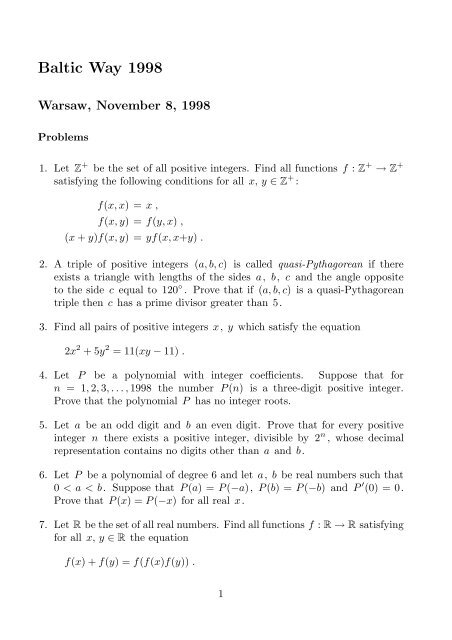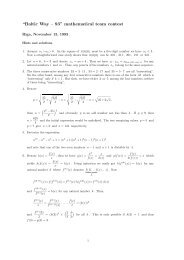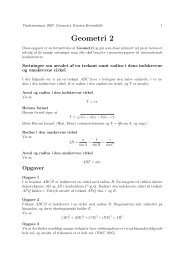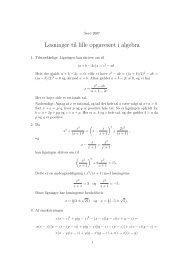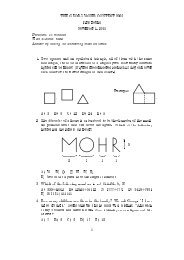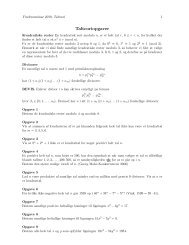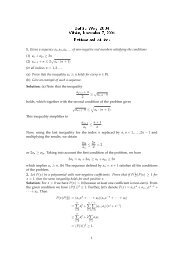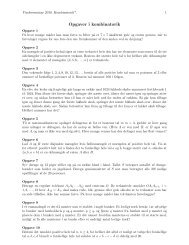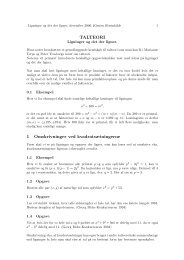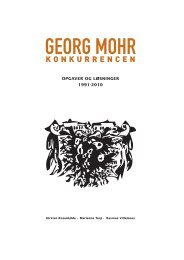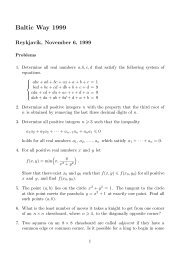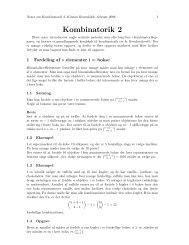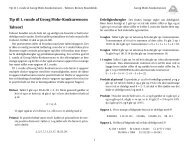Create successful ePaper yourself
Turn your PDF publications into a flip-book with our unique Google optimized e-Paper software.
Baltic Way 1998<br />
Warsaw, November 8, 1998<br />
Problems<br />
1. Let Z + be the set of all positive integers. Find all functions f : Z + → Z +<br />
satisfying the following conditions for all x, y ∈ Z + :<br />
f(x, x) = x ,<br />
f(x, y) = f(y, x) ,<br />
(x + y)f(x, y) = yf(x, x+y) .<br />
2. A triple of positive integers (a, b, c) is called quasi-Pythagorean if there<br />
exists a triangle with lengths of the sides a, b, c and the angle opposite<br />
to the side c equal to 120 ◦ . Prove that if (a, b, c) is a quasi-Pythagorean<br />
triple then c has a prime divisor greater than 5.<br />
3. Find all pairs of positive integers x, y which satisfy the equation<br />
2x 2 + 5y 2 = 11(xy − 11) .<br />
4. Let P be a polynomial with integer coefficients. Suppose that for<br />
n = 1, 2, 3, . . . , 1998 the number P (n) is a three-digit positive integer.<br />
Prove that the polynomial P has no integer roots.<br />
5. Let a be an odd digit and b an even digit. Prove that for every positive<br />
integer n there exists a positive integer, divisible by 2 n , whose decimal<br />
representation contains no digits other than a and b.<br />
6. Let P be a polynomial of degree 6 and let a, b be real numbers such that<br />
0 < a < b. Suppose that P (a) = P (−a), P (b) = P (−b) and P ′ (0) = 0.<br />
Prove that P (x) = P (−x) for all real x.<br />
7. Let R be the set of all real numbers. Find all functions f : R → R satisfying<br />
for all x, y ∈ R the equation<br />
f(x) + f(y) = f(f(x)f(y)) .<br />
1
8. Let Pk(x) = 1 + x + x 2 + · · · + x k−1 . Show that<br />
n�<br />
� �<br />
n<br />
Pk(x) = 2<br />
k<br />
n−1 �<br />
1 + x<br />
�<br />
Pn<br />
2<br />
k=1<br />
for every real number x and every positive integer n.<br />
9. Let the numbers α, β satisfy 0 < α < β < π/2 and let γ and δ be the<br />
numbers defined by the conditions:<br />
(i) 0 < γ < π/2, and tan γ is the arithmetic mean of tan α and tan β ;<br />
(ii) 0 < δ < π/2, and<br />
Prove that γ < δ .<br />
1<br />
cos δ<br />
is the arithmetic mean of<br />
1<br />
cos α and<br />
1<br />
cos β .<br />
10. Let n � 4 be an even integer. A regular n-gon and a regular (n−1)-gon<br />
are inscribed into the unit circle. For each vertex of the n-gon consider the<br />
distance from this vertex to the nearest vertex of the (n−1)-gon, measured<br />
along the circumference. Let S be the sum of these n distances. Prove that<br />
S depends only on n, and not on the relative position of the two polygons.<br />
11. Let a, b and c be the lengths of the sides of a triangle with circumradius R.<br />
Prove that<br />
a<br />
R �<br />
2 + b2 2 √ 2a2 + 2b2 .<br />
− c2 When does equality hold?<br />
� 12. In a triangle ABC , BAC = 90 ◦ �<br />
. Point D lies on the side BC and<br />
satisfies BDA = 2� BAD . Prove that<br />
1 1<br />
=<br />
|AD| 2<br />
�<br />
1 1<br />
+<br />
|BD| |CD|<br />
�<br />
.<br />
13. In a convex pentagon ABCDE , the sides AE and BC are parallel and<br />
� ADE = � BDC . The diagonals AC and BE intersect at P . Prove that<br />
� EAD = � BDP and � CBD = � ADP .<br />
14. Given a triangle ABC with |AB| < |AC|. The line passing through B and<br />
parallel to AC meets the external bisector of angle BAC at D . The line<br />
passing through C and parallel to AB meets this bisector at E . Point F<br />
lies on the side AC and satisfies the equality |F C| = |AB|. Prove that<br />
|DF | = |F E|.<br />
2
15. Given an acute triangle ABC . Point D is the foot of the perpendicular<br />
from A to BC . Point E lies on the segment AD and satisfies the equation<br />
|AE| |CD|<br />
=<br />
|ED| |DB| .<br />
Point F is the foot of the perpendicular from D to BE . Prove that<br />
� AF C = 90 ◦ .<br />
16. Is it possible to cover a 13 × 13 chessboard with forty-two tiles of size 4 × 1<br />
so that only the central square of the chessboard remains uncovered? (It is<br />
assumed that each tile covers exactly four squares of the chessboard, and<br />
the tiles do not overlap.)<br />
17. Let n and k be positive integers. There are nk objects (of the same size)<br />
and k boxes, each of which can hold n objects. Each object is coloured<br />
in one of k different colours. Show that the objects can be packed in the<br />
boxes so that each box holds objects of at most two colours.<br />
18. Determine all positive integers n for which there exists a set S with the<br />
following properties:<br />
(i) S consists of n positive integers, all smaller than 2 n−1 ;<br />
(ii) for any two distinct subsets A and B of S , the sum of the elements<br />
of A is different from the sum of the elements of B .<br />
19. Consider a ping-pong match between two teams, each consisting of 1000<br />
players. Each player played against each player of the other team exactly<br />
once (there are no draws in ping-pong). Prove that there exist ten players,<br />
all from the same team, such that every member of the other team has lost<br />
his game against at least one of those ten players.<br />
20. We say that an integer m covers the number 1998 if 1, 9, 9, 8 appear in<br />
this order as digits of m. (For instance, 1998 is covered by 215993698 but<br />
not by 213326798.) Let k(n) be the number of positive integers that cover<br />
1998 and have exactly n digits (n � 5), all different from 0. What is the<br />
remainder of k(n) in division by 8?<br />
<strong>Solutions</strong><br />
1. Answer: f(x, y) = lcm (x, y) is the only such function.<br />
3
We first show that there is at most one such function f . Let z � 2 be<br />
an integer. Knowing the values f(x, y) for all x, y with 0 < x, y < z , we<br />
compute f(x, z) for 0 < x < z using the third equation (with y = z − x);<br />
then from the first two equations we get the values f(z, y) for 0 < y � z .<br />
Hence, if f exists then it is unique.<br />
Experimenting a little, we can guess that f(x, y) is the least common multiple<br />
of x and y . It remains to verify that the least-common-multiple function<br />
satisfies the given equations. The first two are clear, and for the third one:<br />
(x + y) · lcm (x, y) = (x + y) ·<br />
xy<br />
= y ·<br />
gcd(x, y)<br />
= y · lcm (x, x + y) .<br />
x(x + y)<br />
gcd(x, x + y) =<br />
2. By the cosine law, a triple of positive integers (a, b, c) is quasi-Pythagorean<br />
if and only if<br />
c 2 = a 2 + ab + b 2 . (1)<br />
If a triple (a, b, c) with a common divisor d > 1 satisfies (1), then so<br />
�<br />
a b c<br />
�<br />
does the reduced triple , , . Hence it suffices to prove that in every<br />
d d d<br />
irreducible quasi-Pythagorean triple the greatest term c has a prime divisor<br />
greater than 5. Actually, we will show that in that case every prime divisor<br />
of c is greater than 5.<br />
Let (a, b, c) be an irreducible triple satisfying (1). Note that then a, b and<br />
c are pairwise coprime. We have to show that c is not divisible by 2, 3<br />
or 5.<br />
If c were even, then a and b (coprime to c) should be odd, and (1) would<br />
not hold.<br />
Suppose now that c is divisible by 3, and rewrite (1) as<br />
4c 2 = (a + 2b) 2 + 3a 2 . (2)<br />
Then a + 2b must be divisible by 3. Since a is coprime to c, the number<br />
3a 2 is not divisible by 9. This yields a contradiction since the remaining<br />
terms in (2) are divisible by 9.<br />
Finally, suppose c is divisible by 5 (and hence a is not). Again we get a<br />
contradiction with (2) since the square of every integer is congruent to 0,<br />
4
1 or −1 modulo 5; so 4c 2 − 3a 2 ≡ ±2 (mod 5) and it cannot be equal to<br />
(a + 2b) 2 . This completes the proof.<br />
Remark. A yet stronger claim is true: If a and b are coprime, then every<br />
prime divisor p > 3 of a 2 + ab + b 2 is of the form p = 6k + 1. (Hence<br />
every prime divisor of c in an irreducible quasi-Pythagorean triple (a, b, c)<br />
has such a form.)<br />
This stronger claim can be proved by observing that p does not divide a<br />
and the number g = (a + 2b)a (p−3)/2 is an integer whose square satisfies<br />
g 2 = (a + 2b) 2 a p−3 = (4(a 2 + ab + b 2 ) − 3a 2 )a p−3 ≡ −3a p−1 ≡<br />
≡ −3 (mod p) .<br />
Hence −3 is a quadratic residue modulo p. This is known to be true only<br />
for primes of the form 6k+1; proofs can be found in many books on number<br />
theory, e.g. [1].<br />
Reference. [1] K. Ireland, M. Rosen, A Classical Introduction to Modern<br />
Number Theory, Second Edition, Springer-Verlag, New York 1990.<br />
3. Answer: x = 14, y = 27.<br />
Rewriting the equation as 2x 2 − xy + 5y 2 − 10xy = −121 and factoring we<br />
get:<br />
(2x − y) · (5y − x) = 121 .<br />
Both factors must be of the same sign. If they were both negative, we would<br />
have 2x < y < x<br />
, a contradiction. Hence the last equation represents<br />
5<br />
the number 121 as the product of two positive integers: a = 2x − y and<br />
b = 5y −x, and (a, b) must be one of the pairs (1, 121), (11, 11) or (121, 1).<br />
Examining these three possibilities we find that only the first one yields<br />
integer values of x and y , namely, (x, y) = (14, 27). Hence this pair is the<br />
unique solution of the original equation.<br />
4. Let m be an arbitrary integer and define n ∈ {1, 2, . . . , 1998} to be such<br />
that m ≡ n (mod 1998). Then P (m) ≡ P (n) (mod 1998). Since P (n) as a<br />
three-digit number cannot be divisible by 1998, then P (m) cannot be equal<br />
to 0. Hence P has no integer roots.<br />
5. If b = 0, then N = 10 n a meets the demands. For the sequel, suppose<br />
b �= 0.<br />
5
Let n be fixed. We prove that if 1 � k � n, then we can find a positive<br />
integer mk < 5 k such that the last k digits of mk2 n are all a or b. Clearly,<br />
for k = 1 we can find m1 with 1 � m1 � 4 such that m12 n ends with<br />
the digit b. (This corresponds to solving the congruence m12 n−1 ≡ b<br />
2<br />
modulo 5.) If n = 1, we are done. Hence let n � 2.<br />
Assume that for a certain k with 1 � k < n we have found the integer mk .<br />
Let c be the (k+1)-st digit from the right of mk2 n (i.e., the coefficient<br />
of 10 k in its decimal representation). Consider the number 5 k 2 n : it ends<br />
with precisely k zeros, and the last non-zero digit is even; call it d. For<br />
any r , the corresponding digit of the number mk2 n + r5 k 2 n will be c + rd<br />
modulo 10. By a suitable choice of r � 4 we can make this digit be either<br />
a or b, according to whether c is odd or even. (As before, this corresponds<br />
to solving one of the congruences r · d a − c<br />
≡<br />
2 2<br />
or r · d b − c<br />
≡<br />
2 2<br />
modulo 5.)<br />
Now, let mk+1 = mk + r5 k . The last k+1 digits of mk+12 n are all a or b.<br />
As mk+1 < 5 k +4·5 k = 5 k+1 , we see that mk+1 has the required properties.<br />
This process can be continued until we obtain a number mn such that the<br />
last n digits of N = mn2 n are a or b. Since mn < 5 n , the number N has<br />
at most n digits, all of which are a or b.<br />
Alternative solution. The case b = 0 is handled as in the first solution.<br />
Assume that b �= 0. We prove the statement by induction on n, postulating,<br />
in addition, that N (the integer we are looking for) must be an n-digit<br />
number.<br />
For n = 1 we take the one-digit number b. Assume the claim is true for a<br />
certain n � 1, with N ≡ 0 (mod 2 n ) having exactly n digits, all a or b;<br />
thus N < 10 n . Define<br />
N ∗ � n n+1<br />
10 b + N if N ≡ 0 (mod 2 ) ,<br />
=<br />
10 n a + N if N ≡ 2 n (mod 2 n+1 ) .<br />
Clearly, N ∗ is an (n+1)-digit number, satisfying<br />
N ∗ � n+1<br />
0 + 0 (mod 2 ) in the first case,<br />
≡<br />
2 n + 2 n (mod 2 n+1 ) in the second case.<br />
In both cases N ∗ is divisible by 2 n+1 , and we have the induction claim.<br />
The result follows.<br />
6
6. The polynomial Q(x) = P (x) − P (−x), of degree at most 5, has roots at<br />
−b, −a, 0, a and b; these are five distinct numbers. Moreover, Q ′ (0) = 0,<br />
showing that Q has a multiple root at 0. Thus Q must be the constant 0,<br />
i.e. P (x) = P (−x) for all x.<br />
7. Answer: f(x) ≡ 0 is the only such function.<br />
Choose an arbitrary real number x0 and denote f(x0) = c. Setting<br />
x = y = x0 in the equation we obtain f(c 2 ) = 2c. For x = y = c 2 the<br />
equation now gives f(4c 2 ) = 4c. On the other hand, substituting x = x0<br />
and y = 4c 2 we obtain f(4c 2 ) = 5c. Hence 4c = 5c, implying c = 0. As<br />
x0 was chosen arbitrarily, we have f(x) = 0 for all real numbers x.<br />
Obviously, the function f(x) ≡ 0 satisfies the equation. So it is the only<br />
solution.<br />
8. Let A and B be the left- and right-hand side of the claimed formula,<br />
respectively. Since<br />
(1 − x)Pk(x) = 1 − x k ,<br />
we get<br />
(1 − x) · A =<br />
n�<br />
k=1<br />
� �<br />
n<br />
(1 − x<br />
k<br />
k ) =<br />
n�<br />
k=0<br />
and<br />
� �<br />
1 + x<br />
(1 − x) · B = 2 1 − · 2<br />
2<br />
n−1 � �<br />
1 + x<br />
Pn =<br />
2<br />
= 2 n<br />
� � �n� 1 + x<br />
1 −<br />
2<br />
� �<br />
n<br />
(1 − x<br />
k<br />
k ) = 2 n − (1 + x) n<br />
= 2 n − (1 + x) n .<br />
Thus A = B for all real numbers x �= 1. Since both A and B are polynomials,<br />
they coincide also for x = 1.<br />
Remark. The desired equality can be also proved without multiplication by<br />
(1 − x), just via regrouping the terms of the expanded Pk ’s and some more<br />
manipulation; this approach is more cumbersome.<br />
9. Let f(t) = � 1 + t 2 . Since f ′′ (t) = (1 + t 2 ) −3/2 > 0, the function f(t) is<br />
7
strictly convex on (0, ∞) . Consequently,<br />
1<br />
cos γ =<br />
�<br />
1 + tan2 � �<br />
tan α + tan β<br />
γ = f(tan γ) = f<br />
<<br />
2<br />
< f(tan α) + f(tan β)<br />
=<br />
2<br />
1<br />
� �<br />
1 1<br />
+ =<br />
2 cos α cos β<br />
1<br />
cos δ ,<br />
and hence γ < δ .<br />
Remark. The use of calculus can be avoided. We only need the midpointconvexity<br />
of f , i.e., the inequality<br />
�<br />
1 + 1<br />
4 (u + v)2 < 1�<br />
1�<br />
1 + u2 + 1 + v2 2<br />
2<br />
for u, v > 0 and u �= v , which is equivalent (via squaring) to<br />
1 + uv < � (1 + u 2 )(1 + v 2 ) .<br />
The latter inequality reduces (again by squaring) to 2uv < u 2 + v 2 , holding<br />
trivially.<br />
Alternative solution. Draw a unit segment OP in the plane and take points<br />
A and B on the same side of line OP so that � P OA = � P OB = 90 ◦ ,<br />
� OP A = α and � OP B = β (see Figure 1). Then we have |OA| = tan α,<br />
|OB| = tan β , |P A| = 1<br />
cos α<br />
Q<br />
B<br />
C<br />
and |P B| = 1<br />
cos β .<br />
Figure 1<br />
8<br />
β<br />
◆<br />
α<br />
A O<br />
P
�<br />
Let C be the midpoint of the segment AB . By hypothesis, we have<br />
tan α + tan β<br />
|OC| =<br />
2<br />
= tan γ , hence OP C = γ and |P C| = 1<br />
cos γ .<br />
Let Q be the point symmetric to P with respect to C . The quadrilateral<br />
P AQB is a parallelogram, and therefore |AQ| = |P B| = 1<br />
ally,<br />
. Eventu-<br />
cos β<br />
2 1 1<br />
= +<br />
cos δ cos α cos β<br />
and hence δ > γ .<br />
Another solution. Set x =<br />
and<br />
= |P A| + |AQ| > |P Q| = 2 · |P C| = 2<br />
cos γ ,<br />
α + β<br />
2<br />
and y =<br />
α − β<br />
2<br />
, then α = x+y , β = x−y<br />
cos α cos β = 1<br />
(cos 2x + cos 2y) =<br />
2<br />
= 1<br />
2 (1 − 2 sin2 x) + 1<br />
2 (2 cos2 y − 1) = cos 2 y − sin 2 x .<br />
By the conditions of the problem,<br />
and<br />
tan γ = 1<br />
�<br />
sin α sin β<br />
�<br />
+ =<br />
2 cos α cos β<br />
1 sin(α + β)<br />
·<br />
2 cos α cos β<br />
1<br />
cos δ<br />
1<br />
�<br />
1 1<br />
�<br />
= + =<br />
2 cos α cos β<br />
1 cos α + cos β<br />
·<br />
2 cos α cos β<br />
Using (3) we hence obtain<br />
tan 2 δ − tan 2 γ =<br />
showing that δ > γ .<br />
= sin x cos x<br />
cos α cos β<br />
= cos x cos y<br />
cos α cos β .<br />
1<br />
cos2 δ − 1 − tan2γ = cos2x cos2y − sin 2 x cos2x cos2α cos2 − 1 =<br />
β<br />
= cos2 x(cos 2 y − sin 2 x)<br />
(cos 2 y − sin 2 x) 2<br />
= cos2 x − cos 2 y + sin 2 x<br />
cos 2 y − sin 2 x<br />
9<br />
− 1 =<br />
=<br />
cos2x cos2y − sin 2 − 1 =<br />
x<br />
sin 2 y<br />
cos α cos β<br />
> 0 ,<br />
(3)
10. For simplicity, take the length of the circle to be 2n(n − 1) rather than<br />
2π . The vertices of the (n−1)-gon A0A1 . . . An−2 divide it into n−1 arcs<br />
of length 2n. By the pigeonhole principle, some two of the vertices of the<br />
n-gon B0B1 . . . Bn−1 lie in the same arc. Assume w.l.o.g. that B0 and B1<br />
lie in the arc A0A1 , with B0 closer to A0 and B1 closer to A1 , and that<br />
|A0B0| � |B1A1|.<br />
Consider the circle as the segment [0, 2n(n−1)] of the real line, with both of<br />
its endpoints identified with the vertex A0 and the numbers 2n, 4n, 6n, . . .<br />
identified accordingly with the vertices A1, A2, A3, . . ..<br />
For k = 0, 1, . . . , n−1, let xk be the “coordinate” of the vertex Bk of the<br />
n-gon. Each arc BkBk+1 has length 2(n − 1). By the choice of labelling,<br />
we have<br />
0 � x0 < x1 = x0 + 2(n − 1) � 2n<br />
and, moreover, x0 − 0 � 2n − x1 . Hence 0 � x0 � 1.<br />
Clearly, xk = x0 + 2k(n − 1) for k = 0, 1, . . . , n−1. It is not hard to see<br />
that (2k − 1)n � xk � 2kn if 1 � k � n<br />
2 , and (2k − 2)n � xk � (2k − 1)n<br />
if n<br />
< k � n − 1. These inequalities are verified immediately by inserting<br />
2<br />
xk = x0 + 2k(n − 1) and taking into account that 0 � x0 � 1.<br />
Summing up, we have:<br />
1) if 1 � k � n<br />
2 , then Bk lies between Ak−1 and Ak , closer to Ak ;<br />
recalling that Ak has “coordinate” 2kn, we see that the distance in<br />
question is equal to 2kn − xk = 2k − x0 ;<br />
2) if n<br />
2 < k � n − 1, then Bk lies between Ak−1 and Ak , closer to Ak−1 ;<br />
the distance in question is equal to xk − (2k − 2)n = x0 − 2k + 2n;<br />
3) for B0 , the distance in question is x0 .<br />
The sum of these distances evaluates to<br />
n/2<br />
�<br />
x0 + (2k − x0) +<br />
k=1<br />
n−1 �<br />
k=n/2+1<br />
(x0 − 2k + 2n)<br />
Note that here x0 appears half of the times with a plus sign and half of the<br />
times with a minus sign. Thus, eventually, all terms x0 cancel out, and the<br />
value of S does not depend on anything but n.<br />
10
11. Answer: equality holds if a = b or the angle opposite to c is equal to 90 ◦ .<br />
Denote the angles opposite to the sides a, b, c by A, B , C , respectively.<br />
By the law of sines we have a = 2R sin A, b = 2R sin B , c = 2R sin C .<br />
Hence, the given inequality is equivalent to each of the following:<br />
R �<br />
4R2 (sin 2 A + sin 2 �<br />
B)<br />
2 8R2 (sin 2 A + sin 2 B) − 4R2 sin 2 ,<br />
C<br />
2(sin 2 A + sin 2 B) − sin 2 C � (sin 2 A + sin 2 B) 2 ,<br />
(sin 2 A + sin 2 B)(2 − sin 2 A − sin 2 B) � sin 2 C ,<br />
(sin 2 A + sin 2 B)(cos 2 A + cos 2 B) � sin 2 C .<br />
The last inequality follows from the Cauchy–Schwarz inequality:<br />
(sin 2 A + sin 2 B)(cos 2 B + cos 2 A) �<br />
� (sin A · cos B + sin B · cos A) 2 = sin 2 C .<br />
Equality requires that sin A = λ cos B and sin B = λ cos A for a certain<br />
real number λ, implying that λ is positive and A, B are acute angles.<br />
From these two equations we conclude that sin 2A = sin 2B . This means<br />
that either 2A = 2B or 2A + 2B = π ; in other words, a = b or C = 90 ◦ .<br />
In each of these two cases the inequality indeed turns into equality.<br />
PSfrag replacements<br />
b<br />
O<br />
C<br />
A c M B<br />
Figure 2<br />
a<br />
Alternative solution. Let A, B , C be the respective vertices of the triangle,<br />
O be its circumcentre and M be the midpoint of AB (see Figure 2). The<br />
length mc = |CM| of the median drawn from C is expressed by the well-<br />
11
known formula<br />
4m 2 c = 2a 2 + 2b 2 − c 2 .<br />
Hence the inequality of the problem can be rewritten as 4Rmc � a 2 + b 2 ,<br />
or 8Rmc � 4m 2 c + c 2 . The last inequality is equivalent to<br />
|mc − R| � � R 2 − (c/2) 2 ,<br />
or � � |MC| − |OC| � � � |OM|, which is the triangle inequality for triangle<br />
COM .<br />
Equality holds if and only if the points C , O , M are collinear. This<br />
happens if and only if a = b or � C = 90 ◦ .<br />
Remark. Yet another solution can be obtained by setting R = abc<br />
(where S<br />
4S<br />
denotes the area of the triangle) and expressing S by Heron’s formula. After<br />
squaring both sides, cross-multiplying and cancelling a lot, the inequality<br />
reduces to (a 2 −b 2 ) 2 (a 2 +b 2 −c 2 ) 2 � 0, with equality if a = b or a 2 +b 2 = c 2 PSfrag replacements<br />
A<br />
B<br />
C<br />
.<br />
O<br />
M<br />
E<br />
a<br />
C<br />
b<br />
c D<br />
O<br />
A B<br />
Figure 3<br />
12. Let O be the circumcentre of triangle ABC (i.e., the midpoint of BC )<br />
and let AD meet the circumcircle again at E (see Figure 3). Then<br />
� BOE = 2� BAE = � CDE , showing that |DE| = |OE|. Triangles ADC<br />
and BDE are similar; hence |AD| |CD|<br />
=<br />
|BD| |DE| ,<br />
|AD| |BD|<br />
=<br />
|CD| |DE|<br />
|AD| |AD| |CD| |BD| |BC| |BC|<br />
+ = + = = = 2<br />
|BD| |CD| |DE| |DE| |DE| |OE|<br />
12<br />
and finally
which is equivalent to the equality we have to prove.<br />
frag replacements<br />
Alternative solution. Let � BAD = α and � CAD = β . By the conditions<br />
of the problem, α + β = 90 ◦ A<br />
(hence sin β = cos α), � BDA = 2α and<br />
� CDA = 2β . By the law of sines,<br />
|AD| sin 3α<br />
=<br />
|BD| sin α = 3 − 4 sin2 α<br />
and<br />
|AD| sin 3β<br />
=<br />
|CD| sin β = 3 − 4 sin2 β = 3 − 4 cos 2 B<br />
C<br />
O<br />
M<br />
a<br />
b<br />
c<br />
A<br />
α .<br />
B<br />
C<br />
Adding<br />
O<br />
these two equalities we get the claimed one.<br />
D<br />
E<br />
C1<br />
D<br />
C2<br />
E<br />
C<br />
A<br />
P<br />
F<br />
Figure 4<br />
13. Let C1 and C2 be the circumcircles of triangles AED and BCD , respectively.<br />
Let DP meet C2 for the second time at F (see Figure 4). Since<br />
� ADE = � BDC , the ratio of the lengths of the segments EA and BC<br />
is equal to the ratio of the radii of C1 and C2 . Thus the homothety with<br />
centre P that takes AE to CB , also transforms C1 onto C2 . The same<br />
homothety transforms the arc DE of C1 onto the arc F B of C2 . Therefore<br />
� EAD = � BDF = � BDP . The second equality is proved similarly.<br />
14. Since the lines BD and AC are parallel and since AD is the external<br />
bisector of � BAC , we have � BAD = � BDA; denote their common size<br />
by α (see Figure 5). Also � CAE = � CEA = α, implying |AB| = |BD|<br />
and |AC| = |CE|. Let B ′ , C ′ , F ′ be the feet of the perpendiculars from<br />
13<br />
B
D<br />
α<br />
B ′<br />
α<br />
A<br />
α<br />
F ′<br />
B C<br />
F<br />
Figure 5<br />
the points B , C , F to line DE . From |F C| = |AB| we obtain<br />
and<br />
|B ′ F ′ | = (|AB| + |AF |) cos α = |AC| cos α = |AC ′ | = |C ′ E|<br />
|DB ′ | = |BD| cos α = |F C| cos α = |F ′ C ′ | ,<br />
Thus |DF ′ | = |F ′ E|, whence |DF | = |F E|.<br />
F<br />
A<br />
E<br />
B D<br />
C<br />
Figure 6<br />
15. Complete the rectangle ADCP (see Figure 6). In view of<br />
|AE| |CD| |AP |<br />
= =<br />
|ED| |DB| |DB| ,<br />
14<br />
P<br />
C ′<br />
α<br />
E
the points B , E , P are collinear. Therefore � DF P = 90 ◦ , and so F<br />
lies on the circumcircle of the rectangle ADCP with diameter AC ; hence<br />
� AF C = 90 ◦ .<br />
16. Answer: no.<br />
Label the horizontal rows by integers from 1 to 13. Assume that the tiling<br />
is possible, and let ai be the number of vertical tiles with their outer squares<br />
in rows i and i+3. Then bi = ai + ai−1 + ai−2 + ai−3 is the number of<br />
vertical tiles intersecting row i (here we assume aj = 0 if j � 0). Since<br />
there are 13 squares in each row, and each horizontal tile covers four (i.e.<br />
an even number) of these, then bi must be odd for all 1 � i � 13 except<br />
for b7 , which must be even.<br />
We now get that a1 = b1 is odd, a2 is even (since b2 = a2 + a1 is odd),<br />
and similarly a3 and a4 are even. Since b5 = a5 + a4 + a3 + a2 is odd, then<br />
a5 must be odd. Continuing this way we find that a6 is even, a7 is odd<br />
(since b7 is even), a8 is odd, a9 is odd and a10 is even. Obviously ai = 0<br />
for i > 10, as no tile is allowed to extend beyond the edge of the board.<br />
But then b13 = a10 must be both even and odd, a contradiction.<br />
Alternative solution. Colour the squares of the board black and white in<br />
the following pattern. In the first (top) row, let the two leftmost squares<br />
be black, the next two be white, the next two black, the next two white,<br />
and so on (at the right end there remains a single black square). In the<br />
second row, let the colouring be reciprocal to that of the first row (two<br />
white squares, two black squares, and so on). If the rows are labelled by 1<br />
through 13, let all the odd-indexed rows be coloured as the first row, and<br />
all the even-indexed ones as the second row (see Figure 7).<br />
Note that there are more black squares than white squares in the board.<br />
Each 4 × 1 tile, no matter how placed, covers two black squares and two<br />
white squares. Thus if a tiling leaves a single square uncovered, this square<br />
must be black. But the central square of the board is white. Hence such a<br />
tiling is impossible.<br />
Another solution. Colour the squares in four colours as follows: colour all<br />
squares in the 1-st column green, all squares in the 2-nd column black, all<br />
squares in the 3-rd column white, all squares in the 4-th column red, all<br />
squares in the 5-th column green, all squares in the 6-th column black etc.,<br />
leaving only the central square uncoloured (see Figure 8). Altogether we<br />
have 3 · 13 = 39 black squares and 3 · 13 − 1 = 38 white squares. Since<br />
15
each 4 × 1 tile covers either one square of each colour or all four squares<br />
of the same colour, then the difference of the numbers of black and white<br />
squares must be divisible by 4. Since 39 − 38 = 1 is not divisible by 4, the<br />
required tiling does not exist.<br />
Figure 7<br />
G B W R G B W R G B W R G<br />
Figure 8<br />
17. If k = 1, it is obvious how to do the packing. Now assume k > 1. There<br />
are not more than n objects of a certain colour — say, pink — and also<br />
not fewer than n objects of some other colour — say, grey. Pack all pink<br />
objects into one box; if there is space left, fill the box up with grey objects.<br />
Then remove that box together with its contents; the problem gets reduced<br />
to an analogous one with k−1 boxes and k−1 colours. Assuming inductively<br />
that the task can be done in that case, we see that it can also be done<br />
for k boxes and colours. The general result follows by induction.<br />
18. Answer: all integers n � 4.<br />
Direct search shows that there is no such set S for n = 1, 2, 3. For<br />
n = 4 we can take S = {3, 5, 6, 7}. If, for a certain n � 4 we have a<br />
set S = {a1, a2, . . . , an} as needed, then the set S ∗ = {1, 2a1, 2a2, . . . , 2an}<br />
satisfies the requirements for n + 1. Hence a set with the required properties<br />
exists if and only if n � 4.<br />
19. We start with the following observation: In a match between two teams (not<br />
necessarily of equal sizes), there exists in one of the teams a player who won<br />
his games with at least half of the members of the other team.<br />
16
Indeed: suppose there is no such player. If the teams consist of m and<br />
n members then the players of the first team jointly won less than m · n<br />
2<br />
games, and the players of the second team jointly won less than m · n<br />
2<br />
games — this is a contradiction since the total number of games played is<br />
mn, and in each game there must have been a winner.<br />
Returning to the original problem (with two equal teams of size 1000),<br />
choose a player who won his games with at least half of the members of<br />
the other team — such a player exists, according to the observation above,<br />
and we shall call his team “first” and the other team “second” in the sequel.<br />
Mark this player with a white hat and remove from further consideration<br />
all those players of the second team who lost their games to him. Applying<br />
the same observation to the first team (complete) and the second team<br />
truncated as explained above, we again find a player (in the first or in the<br />
second team) who won with at least half of the other team members. Mark<br />
him with a white hat, too, and remove the players who lost to him from<br />
further consideration.<br />
We repeat this procedure until there are no players left in one of the teams;<br />
say, in team Y . This means that the white-hatted players of team X<br />
constitute a group with the required property (every member of team Y<br />
has lost his game to at least one player from that group). Each time when a<br />
player of team X was receiving a white hat, the size of team Y was reduced<br />
at least by half; and since initially the size was a number less than 2 10 , this<br />
could not happen more than ten times.<br />
Hence the white-hatted group from team X consists of not more than ten<br />
players. If there are fewer than ten, round the group up to ten with any<br />
players.<br />
20. Answer: 1.<br />
Let 1 � g < h < i < j � n be fixed integers. Consider all n-digit numbers<br />
a = a1a2 . . . an with all digits non-zero, such that ag = 1, ah = 9, ai = 9,<br />
aj = 8 and this quadruple 1998 is the leftmost one in a; that is,<br />
⎧<br />
al �= 1<br />
⎪⎨<br />
al �= 9<br />
if l < g ;<br />
if g < l < h ;<br />
al ⎪⎩<br />
�= 9<br />
al �= 8<br />
if h < l < i ;<br />
if i < l < j .<br />
17
There are kghij(n) = 8 g−1 · 8 h−g−1 · 8 i−h−1 · 8 j−i−1 · 9 n−j such numbers a.<br />
Obviously, kghij(n) ≡ 1 (mod 8) for g = 1, h = 2, i = 3, j = 4, and<br />
kghij(n) ≡ 0 (mod 8) in all other cases. Since k(n) is obtained by summing<br />
up the values of kghij(n) over all possible choicecs of g, h, i, j , the<br />
remainder we are looking for is 1.<br />
18


